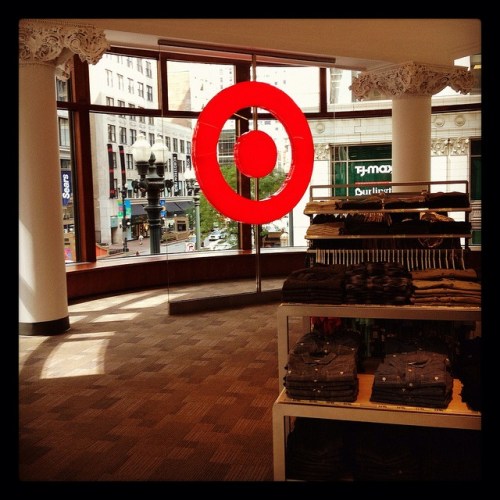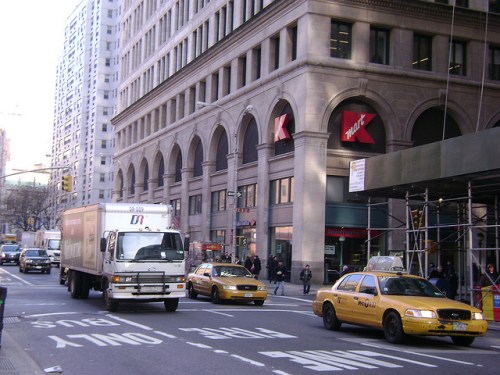Many Chicagoans gasped twice in the last five years–initially when famed local department store Carson Pirie Scott announced it was closing its downtown State Street flagship after over a century, and again once discount retailer Target announced it would lease the bottom two floors of the redeveloped historic structure (designed by Louis Sullivan in 1899, above).
The new store, which opened last week, is an example of a growing trend of big-box retailers opening new urban locations, as a saturated suburbia no longer offers opportunities for growth, and and inner-city populations are seen as the last under-served frontier (note in the interior shot from the Target above, both Sears and TJ Maxx are visible across the street). Rather than imposing suburban building models onto dense downtown environments, these retailers are inventing new urban models that are smaller, more flexible, and more compatible with pedestrian-friendly environments (see this recent article from the New York Times on the subject). The Target on State Street has been getting some good reviews for its sensitivity to the historic architecture, its well-designed storefronts, and the modest proportions of its famous logo.
As Birmingham strives to entice more retail to the city center and adjacent neighborhoods, retailers are increasingly primed to work with cities using solid urban design principles, rather than insisting on older, more suburban paradigms (above, the Kmart off of Astor Place in Manhattan, in the former Wanamaker’s Department Store). In a place like downtown Manhattan (or to a lesser degree downtown Chicago), the entry of big-box retailers has been controversial due to the preexisting network of independent retailers in those neighborhoods. In Birmingham, that network doesn’t widely exist, making the entry of new retailers a much more promising possibility–especially if we insist on the kind of good design for which, well, Target has made a name for itself.
Ground floor/basement of Pizitz Building, perhaps? As long as we can still fit in the V. Richard’s branch…
[thanks to New York Times for Target, chicagoist for Target interior, and locationresearch for Kmart]




That’s one gorgeous corner in Chicago. Lower floors were empty last time I passed it. Nice to see it back.
Sullivan indeed created one of the most beautiful corners in Chicago. Last time I was there maybe 8 years ago, it was still a (somewhat faded) department store. Definitely good to see it back in use! Thanks.
hate to be the bearer of bad tidings but v richards forest park location is for sale- no idea what their plans may be but that does not bode well for any future branches.
Do you have any more information on that sale? Is the place still open? I was there for brunch a few weeks ago. You are right; this news does not bode well for future branches…
I was really delighted with Target in Chicago until I read about V. Richard’s here. Was he undone by Publix and Whole Foods? Or is Rick just retiring? The place is always busy.
In any case, the use of the great department stores is welcome, and Pizitz would be a perfect house for one. I certainly understand the controversy in cases where the big boxes threaten to undermine local businesses, but in a busy urban setting I should think that lots of activity in one place would generate activity all around.
Exactly–certain “chain” retailers, if done the right way in urban locations, can excite indies to locate nearby. The problem starts when too many chains drive rents up and indies can no longer afford the place. We’re a long way from that, though.
And I hope the V. Richard’s sale is a real estate mechanism only, rather than anything to do with the business itself? Because that would be sad indeed. Publix and Whole Foods I’m sure have made it tougher. Thanks.
I just have seen the listing for a while on the ONB site- it is still open… hopefully, they are just trying to do a lease back.
http://www.yourcitycenter.com/AvailableBuildings.aspx
Let’s hope you are right. Regardless of the Pizitz, I do think an urban grocer will come to downtown within the next few years if things continue to progress. Thanks.
I say let’s go big and bring in a Crate & Barrel (even their outlet is fun and great looking in Chicago, or another retailer specializing in downsized/urban living furnishings. It would be great to enrich the area with more upscale boutiques,gourmet to go, and housewares like you find throughout the Chicago neighborhoods.
C&B, CB2, West Elm!
actually, to allay the fears I imposed, I just noticed something on the listing I had overlooked before. The listing is shown as investment property rather than owner occupied, so it is highly likely they are just looking for a lease-back deal.
Thanks, that’s making us all feel better!
The old Booker T. Washington Insurance building is begging to be turned into a Publix.
Urban Publix ground floor, apartments upstairs, parking deck already adjacent–perfect!
Every time I pass by it, I marvel at its 150+ parking spaces. It seems ready made for redevelopment.
It is indeed good to see these wonderful old buildings in NYC and Chicago being renovated for today’s market. I am so sad to see old, well established stores like Woody’s in D.C. close their doors, but that is just business. I am encouraged to see wonderful architecture survive the ups and downs of capitalism.
I lived in DC back in the 1980’s when trips to Woodie’s, Raleigh’s, and Garfinkel’s were part of daily life. It’s fair to mourn the passing of local department stores, and the generic quality of national retail. Hopefully the recycling of historic buildings into new uses, along with the much greater access to retail choice (via internet) that we all have today, helps make up for the loss of locally owned stores. Thanks.
I was recently in Charleston, SC and went into a Publix that was a converted warehouse. It made me think about the old steam plant downtown and possible uses for that structure as either a grocery store another type of big box. Anyone have the latest on that place?
Alabama Power is no doubt working on options for reuse of the steam plant. My own guess is it would be something of a more public/civic nature vs. retail, but it will probably be sometime before we know the plan. Thanks.
This is a little off subject, and talk of it used to hit walls of opposition from “community” advocates, but what about the old Langford proposal of creating a new Southtown housing project somewhere else in the city and freeing up that space (across the Expressway from St Vincent’s Hospital) into a posh sort of high-rise community (okay hold on, I’m going somewhere with this…) and then redeveloping nearby 7th Ave S into a new retail corridor, which it once was in the first half of the 20th century? I have doubts that an “island” of retail in the center of downtown is doable, even with a sizable loft community around it. BUT, you let the existing residential hubs (Highland Park, Forest Park, Avondale) creep down into the downtown area–contiguously–and it might just work over time. Re-occupy “southside” and “midtown” areas, connecting eventually with loft district, and moving, glacier like (gradually but firmly), westward. If development is sparked from Ensley and West End, it can creep eastward as well, and they can meet in the middle, like a bridge ingeniously constructed over a great canyon, or the Chunnel!